Grayscale February report: Bitcoin may hit a new high this year
Compilation: W3C DAO
Recently, Grayscale released a February report, which stated that Bitcoin may reach an all-time high again later this year. The following is the content of the report:
In February, the price of Bitcoin rose 45%, surpassing $60,000 for the first time since the fourth quarter of 2021, and is only 9% below its all-time high.
We observe that the price increase may be influenced by large inflows into new US-listed ETFs and expectations of the Bitcoin issuance halving in April.
In a volatile month for traditional assets, the cryptocurrency market posted solid returns in February 2024, as a newly launched spot Bitcoin ETF attracted steady inflows while also benefiting from multiple a positive fundamental development.
Currently, the main risk to digital asset valuations may be the Federal Reserve’s monetary policy: inflation picked up again in February, which could delay interest rate cuts until later this year or longer.
Bitcoin and Ethereum performed well in February across crypto and traditional financial markets, both in absolute terms and in returns relative to volatility.
Global bond markets have fallen this month as a pickup in inflation dimmed the chances of U.S. and European central banks cutting interest rates. Meanwhile, stocks were mostly higher, with China and other emerging market stocks in particular outperforming.
In recent years, the connection between cryptocurrencies and traditional markets has become increasingly closer. However, the performance of major coins in February once again highlighted the diversification benefits of crypto assets.
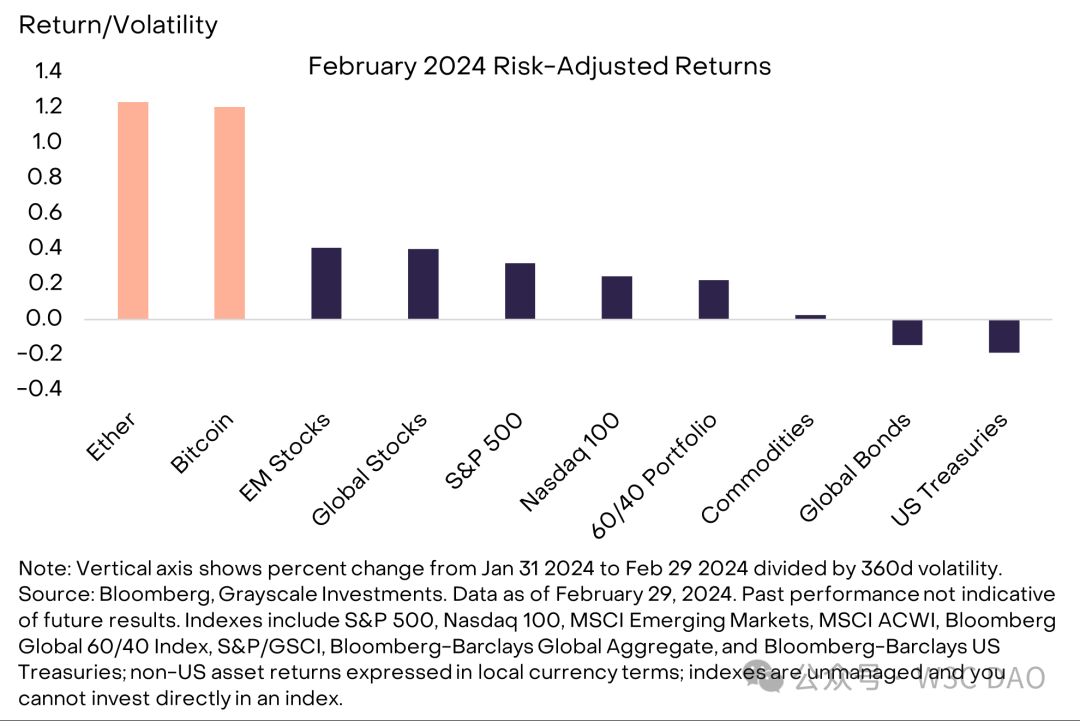
For Bitcoin, the solid returns may reflect, at least in part, steady inflows into the new U.S.-listed spot Bitcoin ETF.
From its launch on January 11 to the end of that month, the 10 spot Bitcoin ETFs had a cumulative net inflow of US$1.46 billion. In February, net inflows accelerated significantly, with net inflows reaching US$6 billion throughout the month. Across crypto exchange-traded products (ETPs), we estimate net inflows totaled $6.2 billion in February, more than double monthly records dating back to October 2021.
Notably, U.S.-listed gold ETFs have seen net outflows since the launch of the spot Bitcoin ETF, perhaps signaling a shift by investors from one “store of value” asset to another.
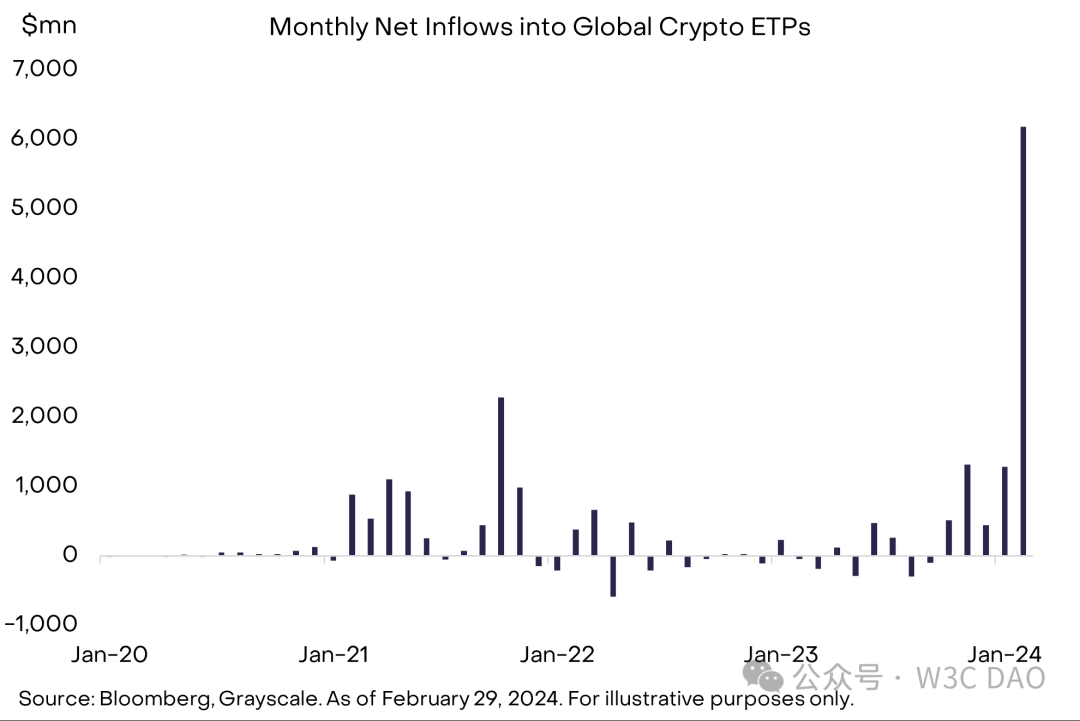
From the perspective of spot Bitcoin ETF inflows, according to the current block reward rate, the Bitcoin network will produce about 900 new coins every day, which is worth about 5,400 Thousands of dollars in Bitcoin (assuming an average price per coin of $60,000).
Bitcoin issuance will drop in half by April 2024 - an event scheduled every four years known as the "halving" - when daily issuance will drop to 450 bits currency, that is, Bitcoin worth approximately $27 million.
Net inflows into U.S.-listed spot Bitcoin ETFs averaged $208 million per day in February, far outpacing the pace of new supply even before the halving. We believe an imbalance between new demand and limited new issuance may have contributed to the increase in valuations.
Although Bitcoin delivered solid returns in February, it was beaten by the second-largest crypto asset by market capitalization, Ethereum (ETH), which gained 47% during the month.
The market appears to be anticipating a key upgrade to the Ethereum network scheduled for March 13. Ethereum is pursuing a modular design philosophy, and over time, more activity will occur on the Layer 2 blockchain connected to the Layer 1 mainnet.
The upcoming upgrade will accommodate this growth by providing Layer 2 with designated storage space on Ethereum, aiming to reduce its data costs and thereby increase its operating profits. Ethereum may also benefit from other tailwinds, including a focus on “re-collateralization” technology — Eigenlayer, a leader in the space, raised $100 million from venture capital firm a16z this month — and expectations for the future of the ETH Denver conference , and the prospect of regulatory approval for the ETH ETF.
The best-performing segment in February was the Utilities and Services cryptocurrency space, up 53%. This product category includes tokens related to artificial intelligence (AI) technologies, some of which have seen huge gains.
While not originally designed with artificial intelligence applications in mind, we expect Filecoin (FIL) to have benefited from market interest in this topic. The project initially focused on decentralized storage but now includes smart contracts and computing infrastructure, which could lead to synergies with blockchain-based artificial intelligence applications. On February 16, Filecoin announced an integration with Solana to provide a decentralized block history for the network. Filecoin currently holds the dominant market share (~99%) in decentralized data storage.
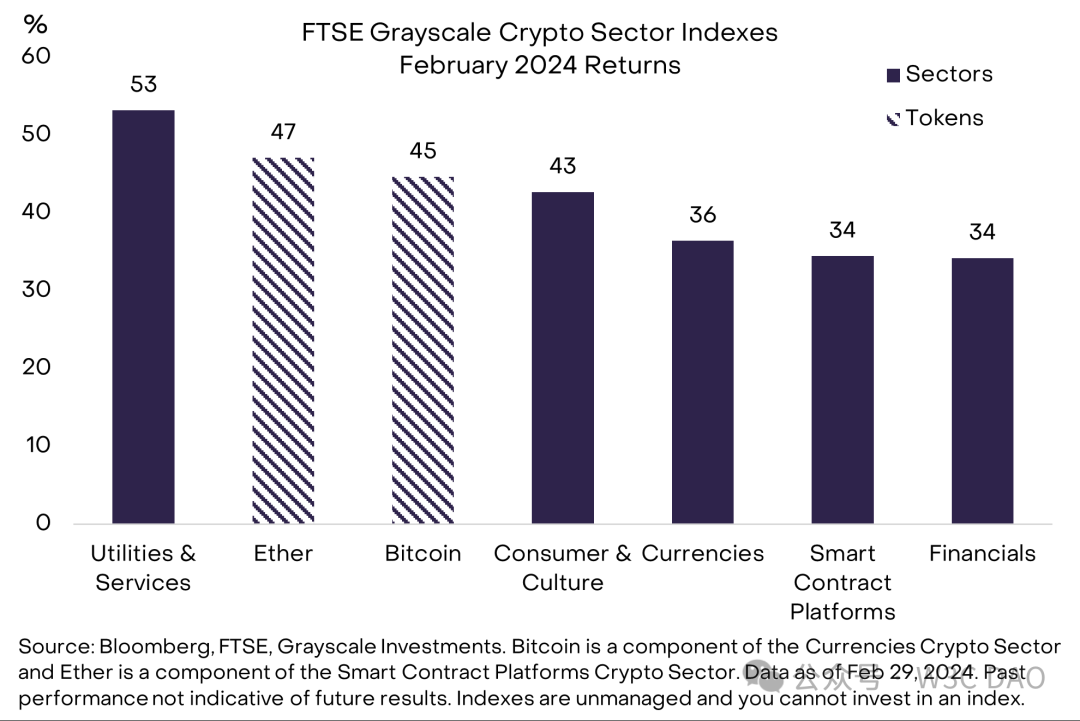
On the other hand, the financial cryptocurrency industry is up 34%. Part of the appreciation is due to the proliferation of governance tokens on decentralized exchange (DEX) Uniswap. The platform generates revenue through transaction fees, a portion of which is transferred to the Uniswap Foundation when users visit the front-end website. However, no revenue currently flows directly to holders of the UNI governance token.
On February 23, the Uniswap Foundation’s head of governance proposed distributing fee revenue directly to UNI holders who stake their tokens on the platform and delegate voting rights. If implemented, the UNI token will receive a portion of transaction fees from one of the largest decentralized finance applications by transaction volume.
The increase in valuations in February was accompanied by an increase in transaction volume and a rise in various on-chain metrics, especially Ethereum. For example, average daily ETH spot trading volume reached $5.8 billion in February, the highest level since September 2021, according to Coin Metrics data. The value of all transfers on the Ethereum network also increased to its highest level since June 2022.
Finally, the total stablecoin market capitalization increased by another $5.5 billion this month. In related news, stablecoin issuer Circle announced that it will stop supporting USDC on the Tron blockchain. About 80% of USDC in circulation is on the Ethereum network, and only about 1% is on Tron (of which Tether is the main stablecoin).
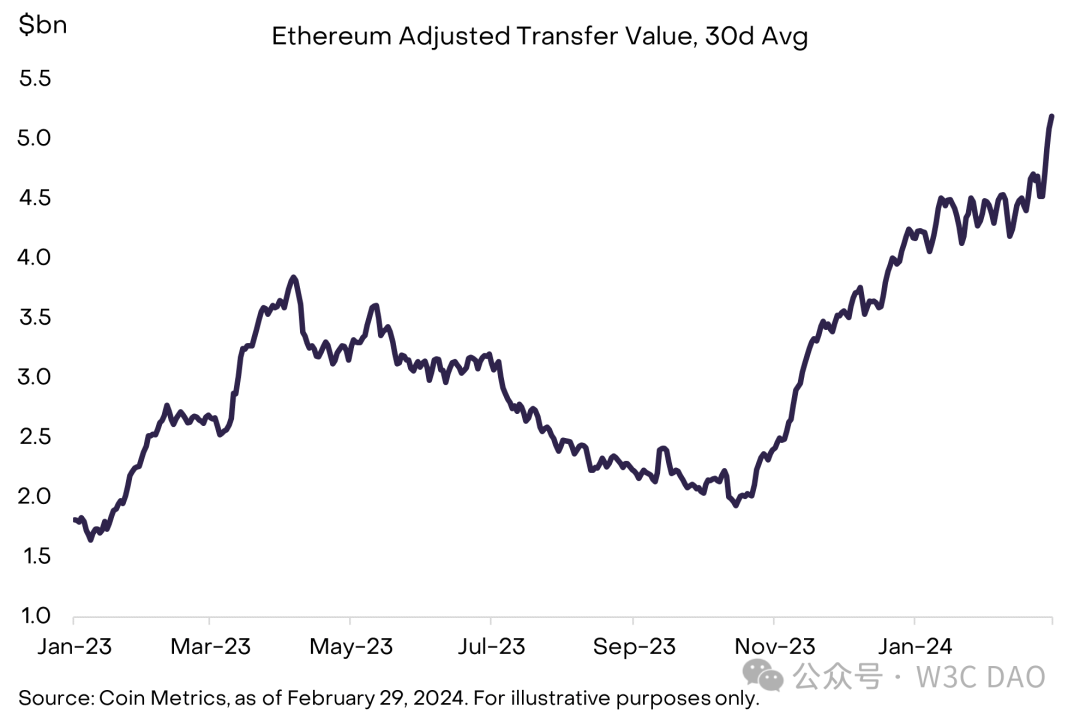
The cryptocurrency market has had a strong year on the back of Bitcoin ETF inflows and a variety of fundamental positives. However, an important lesson from the last crypto cycle is that macro factors such as Federal Reserve monetary policy and economic conditions can significantly impact crypto asset valuations.
If the macro market outlook remains positive, a number of tailwinds for the sector – including Bitcoin’s halving and Ethereum’s impending upgrade – could cause token prices to rise further this year. Bitcoin’s price is currently just 9% below its all-time high, so a new all-time high is likely to be reached later this year.
In contrast, a less favorable macro outlook may dampen valuations. In the fourth quarter of 2023, Bitcoin may benefit from the Federal Reserve's shift from raising interest rates to cutting interest rates.
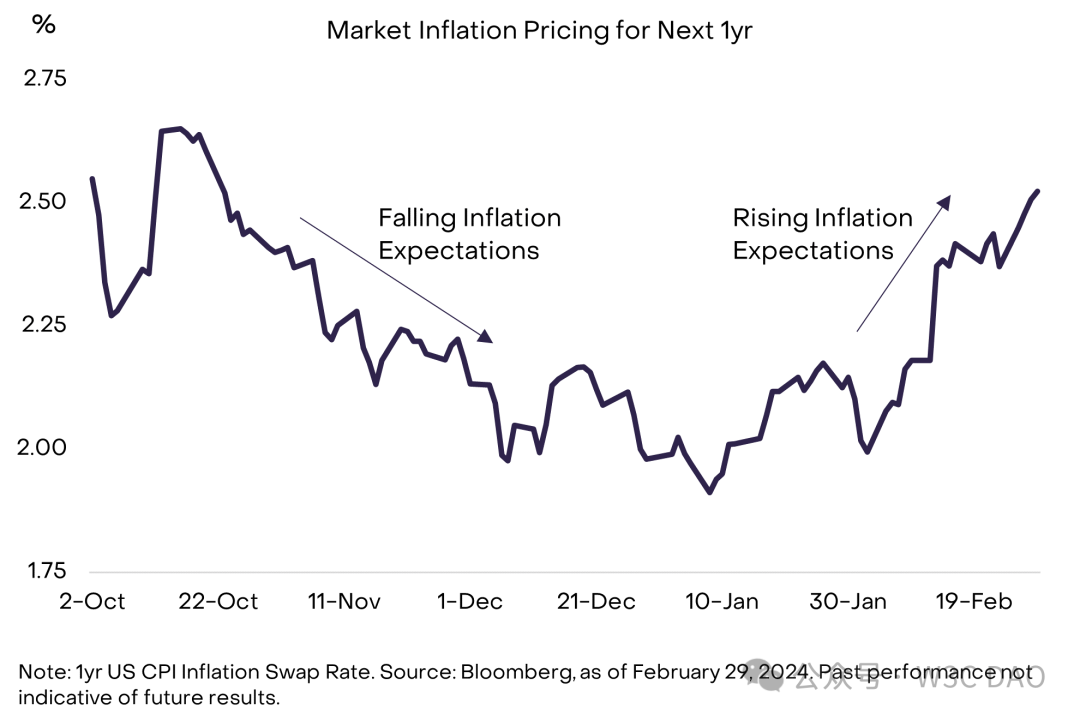
#If the central bank does cut interest rates in the coming months, it could weaken the dollar and support the valuations of assets that compete with the greenback, including Bitcoin. But in January, the steady decline in U.S. inflation appeared to be slowing or pausing on some measures, and markets began to turn higher on the inflation outlook. If inflation remains high, Fed officials may consider delaying rate cuts until later this year or into 2025. Generally speaking, rising U.S. interest rates can be positive for the value of the U.S. dollar and negative for Bitcoin.
We believe that the most likely outcome is that U.S. consumer price inflation will continue to decline, prompting the Federal Reserve to eventually cut interest rates. But cryptocurrency investors should keep an eye on the upcoming inflation report and updated policy rate guidance from the Federal Reserve at its next meeting on March 20.
Written at the end
Grayscale released a February market report stating that the price of Bitcoin rose by about 45% in February, surpassing $60,000 for the first time since the fourth quarter of 2021.
This phenomenon reflects heavy inflows into U.S. ETFs and expectations for Bitcoin’s halving in April.
In addition, as can be seen from the last crypto cycle, macro factors such as the Federal Reserve’s monetary policy and economic conditions may seriously affect crypto asset valuations. If the macro market outlook remains optimistic, it may cause cryptocurrency prices to rise. Further gains have taken place this year, with Bitcoin currently trading just 9% below its all-time high, so a new all-time high may be possible later this year.
The above is the detailed content of Grayscale February report: Bitcoin may hit a new high this year. For more information, please follow other related articles on the PHP Chinese website!

Hot AI Tools

Undresser.AI Undress
AI-powered app for creating realistic nude photos

AI Clothes Remover
Online AI tool for removing clothes from photos.

Undress AI Tool
Undress images for free

Clothoff.io
AI clothes remover

Video Face Swap
Swap faces in any video effortlessly with our completely free AI face swap tool!

Hot Article

Hot Tools

Notepad++7.3.1
Easy-to-use and free code editor

SublimeText3 Chinese version
Chinese version, very easy to use

Zend Studio 13.0.1
Powerful PHP integrated development environment

Dreamweaver CS6
Visual web development tools

SublimeText3 Mac version
God-level code editing software (SublimeText3)

Hot Topics
 1670
1670
 14
14
 1428
1428
 52
52
 1329
1329
 25
25
 1274
1274
 29
29
 1256
1256
 24
24
 New Hampshire becomes the first state to establish strategic Bitcoin BTC/USD reserves
May 08, 2025 pm 11:18 PM
New Hampshire becomes the first state to establish strategic Bitcoin BTC/USD reserves
May 08, 2025 pm 11:18 PM
Dennis Porter, founder of SA Fund, revealed on social media that New Hampshire Governor Kelly Ayotte has signed Bill 302 into law. New Hampshire has thus become the first state in the United States to establish a strategic Bitcoin (BTC/USD) reserve, allowing public funds to invest in Apex cryptocurrencies and other digital assets that meet certain standards. Details: Act 302 signed by Gov. Kelly Ayotte not only allows investment in Bitcoin, but also includes other digital assets that meet certain standards, Dennis Por, founder of SatoshiActionFund
 The top ten currency trading platform apps are ranked. The latest ranking of currency speculation platform apps
May 08, 2025 pm 11:00 PM
The top ten currency trading platform apps are ranked. The latest ranking of currency speculation platform apps
May 08, 2025 pm 11:00 PM
The top ten cryptocurrency trading platforms in the world in 2025 are: 1. Binance (Binance), the world's first transaction volume, supports 600 cryptocurrencies, and cold wallet stores 98% of assets; 2. OKX (Euyi), the world's third in contract trading volume, launches the Metacosmic trading hall; 3. Coinbase, the largest compliant exchange in the United States, supports direct US dollar trading, with users exceeding 100 million; 4. Bybit, the world's second in derivative trading volume, launches a liquidity pairing plan; 5. Bitget, the industry-leading copying function, focusing on the Asian market; 6. MEXC Global, focuses on altcoin trading, supports 2,276 cryptocurrencies; 7. Gate.io (Sesame Open), old
 Detailed Guide to Installation and Registration of Binance Binance Exchange (2025 Latest Steps)
May 08, 2025 pm 11:06 PM
Detailed Guide to Installation and Registration of Binance Binance Exchange (2025 Latest Steps)
May 08, 2025 pm 11:06 PM
Binance is one of the world's leading cryptocurrency trading platforms, providing trading services for a variety of digital assets. If you are considering using Binance for cryptocurrency trading, this article will provide you with a detailed installation and registration guide.
 Ouyi ios official website entrance okx Ouyi official website Apple mobile phone registration entrance
May 08, 2025 pm 11:09 PM
Ouyi ios official website entrance okx Ouyi official website Apple mobile phone registration entrance
May 08, 2025 pm 11:09 PM
If you are an Apple mobile phone user and are interested in cryptocurrency trading, then you must not miss the OKX Ouyi platform. As one of the world's leading cryptocurrency exchanges, OKX Ouyi provides trading services for a variety of digital assets, covering mainstream currencies such as Bitcoin, Ethereum, Litecoin, etc., and also supports the transaction of a variety of altcoins and emerging tokens. Whether you are a freshly-made investor or an experienced trader, OKX Ouyi can meet your needs. Below we will introduce in detail how to note on the official website of OKX Ouyi through Apple mobile phones
 Yiou official website entrance Yiou exchange Apple entrance official entry
May 08, 2025 pm 11:12 PM
Yiou official website entrance Yiou exchange Apple entrance official entry
May 08, 2025 pm 11:12 PM
A world-renowned digital currency trading platform, established in 2014, is committed to providing users with safe and convenient digital asset trading services. As an international exchange, Yiou supports the transaction of a variety of mainstream and niche digital currencies, attracting users from all over the world. Whether newbies or experienced traders, you can find trading tools and services that suit you on the Yiou platform.
 Binance binance web version entrance Binance binance exchange web version directly enter
May 08, 2025 pm 11:03 PM
Binance binance web version entrance Binance binance exchange web version directly enter
May 08, 2025 pm 11:03 PM
The world's leading cryptocurrency trading platform is famous for its efficient, secure and diverse trading services. Whether you are an experienced trader or a newbie into the cryptocurrency market, Binance has the tools and resources you need. Through Binance web version, users can easily access the trading platform without downloading any applications and conduct trading operations directly through the browser. This article will introduce in detail how to enter the Binance Binance Exchange web version and provide some practical trading tips and precautions.
 okx exchange portal okx trading platform official website login portal
May 08, 2025 pm 11:15 PM
okx exchange portal okx trading platform official website login portal
May 08, 2025 pm 11:15 PM
As the world's leading cryptocurrency trading platform, OKX provides users with diversified trading services and a secure trading environment. Since its establishment, OKX has attracted a large number of users and investors with its strong technical support and rich trading products. Whether you are a novice or a professional trader, OKX can meet your trading needs.
 Top 10 virtual currency exchanges in the currency circle App Latest ranking of the top 10 digital currency exchanges in the currency circle in 2025
May 12, 2025 pm 06:00 PM
Top 10 virtual currency exchanges in the currency circle App Latest ranking of the top 10 digital currency exchanges in the currency circle in 2025
May 12, 2025 pm 06:00 PM
Top 10 virtual currency exchange apps in the currency circle: 1. Binance, 2. OKX, 3. Huobi, 4. Coinbase, 5. Kraken, 6. Bitfinex, 7. Bybit, 8. KuCoin, 9. Gemini, 10. Bitstamp, these platforms are popular for their transaction volume, security and user experience.



